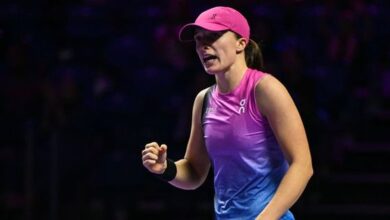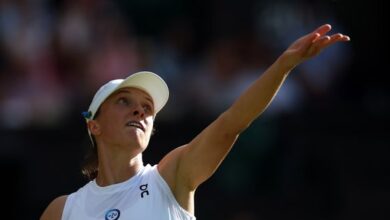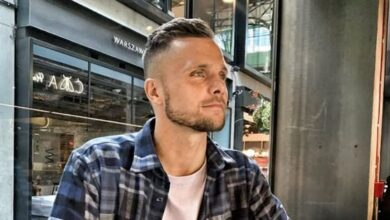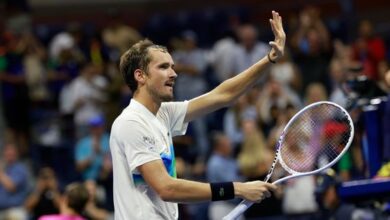ASB Classic: Rafael Nadal reflects on making first ATP Tour final in Auckland in 2004
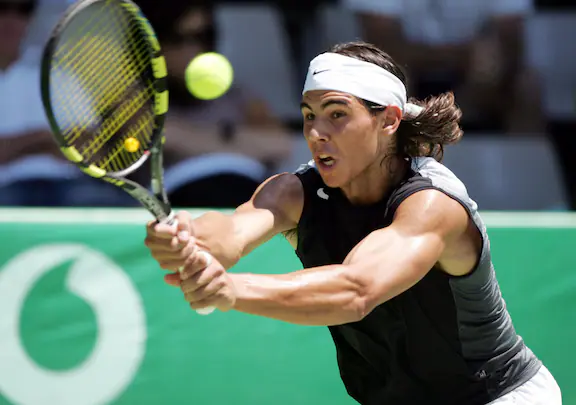
ASB Classic: Rafael Nadal reflects on making first ATP Tour final in Auckland in 2004
Michael Burgess
By Michael Burgess
Specialist Multimedia Sports Journalist·NZ Herald·
3 Jan, 2025 08:00 PM
12 mins to read
Rafael Nadal made the final of the then Heineken Open in Auckland in 2004 at 17 years old, losing in three sets to Dominik Hrbaty. Photo / Photosport
Rafael Nadal made the final of the then Heineken Open in Auckland in 2004 at 17 years old, losing in three sets to Dominik Hrbaty. Photo / Photosport
Ask Rafael Nadal about Auckland and it brings an immediate smile. As unlikely as it sounds, the Spanish legend remembers his time here well.
Nadal ended his incredible career in November. He won 22 grand slams – topped only by Novak Djokovic in men’s tennis – including 14 at Roland Garros. Nadal collected 92 titles and remained inside the top 10 for almost 20 years. He also spent 209 weeks at No 1 and remains the only man to reach the rankings summit in three different decades. The left-hander graced numerous grand arenas around the globe, including four Olympics, but has fond recollections of his time in the Queen City – for good reason.
“It was an important tournament for me,” Nadal tells the Herald. “I played the final there in Auckland and it was my first ATP final. It was one of my first big tournaments.”
Across a career that encompassed more than 1300 professional matches, the humble New Zealand event holds that special milestone, marking his first appearance in the climax of an ATP event. It’s quite remarkable in the context of the other members of the “Big Three”.
Djokovic has never played in New Zealand. Roger Federer came only once, famously losing on an outside court in his first-round match and never returning. But with Nadal, the Auckland crowd and television viewers across the country witnessed the birth of a legend.
Advertisement
Advertise with NZME.
Rafael Nadal arrived in Auckland as a 17-year-old in 2004. Photo / Photosport
Rafael Nadal arrived in Auckland as a 17-year-old in 2004. Photo / Photosport
Nadal arrived in Auckland on January 10, 2004. He was ranked No 48, climbing from 199 in the previous year.
That campaign had included a third-round appearance at Wimbledon, the youngest to reach that stage since Boris Becker in 1984. Nadal had also made the semifinals at Umag in Croatia, stopped by former world No 1 Carlos Moya, but had a modest 15-13 record in ATP-level matches.
The 17-year-old was tired upon arrival – after a long trip from Chennai, where he had lost in the first round to a Frenchman ranked 102 – but made an impression in an early training session.
Advertisement
Advertise with NZME.
“I can remember the excitement,” says former Tennis Auckland operations manager Richard Palmer, who also served as tournament director for many years. “There was a bit of talk about him and they weren’t wrong. You could see straight away. His work ethic, his practice, all the rest of it was just another world.
“I said to some of our kids, ‘go and have a look at this guy, have a look at how it’s done’. He was so focused, his training ethic was fantastic.”
Then-tournament director Graham Pearce had assembled a strong field, including world No 5 Guillermo Coria, former world No 1 Gustavo Kuerten, 2004 French Open champion Gaston Gaudio and Chilean gunslinger Fernando Gonzalez. Other familiar names were Robin Soderling and Todd Martin, with eight players inside the top 40.
Nadal had fourth seed and 1999 champion Sjeng Schalken (No 16) first up, ensuring a centre-court debut. The large Tuesday afternoon crowd wasn’t disappointed, as Nadal gave a captivating display in his 7-6 (2), 6-4 victory.
Discover more
Tennis
‘Both of us deserve to be in that final’
27 Jan 06:29 PM
“He was wearing the muscle shirt, with those biceps,” says former tournament media manager Dave Worsley. “It was like, this guy can’t be a tennis player, with biceps that big. We weren’t used to seeing tennis players that bulked up. That’s probably a memory everybody had.”
The Majorcan retrieved everything, running down seemingly lost causes, at one stage endangering a courtside box. He was a ball of energy, with a unique style, especially on the forehand stage, producing extreme kick and top spin.
“His playing style was really different,” says Worsley. “His forehand finished way up in the air above his head, instead of around his shoulder where forehands should be finishing, something you would not coach anyone to do. And the way the ball would kick up, over people’s heads on the backhand, we hadn’t seen that before.
“His shot-making was different to anyone else at that time and he had muscles on muscles. Everything about him was new.”
Another standout aspect was his fighting spirit, evident in his second-round clash with rising star Mario Ancic. The 1.95m Croatian, who had already shocked Federer in the first round at Wimbledon in 2002, had one of the biggest serves on tour and would reach the last four at SW19 later that year.
Ancic sent down a blitz of aces but Nadal was immovable, saving five break points to prevail 7-6 (0), 7-6 (6) in a two-hour contest.
Advertisement
Advertise with NZME.
“People knew he was good on clay but how good was he going to be on hardcourt? He was starting to show it,” says Worsley.
In the words of an Auckland tournament official, the teenage Nadal had “muscles on muscles”. Photo / Photosport
In the words of an Auckland tournament official, the teenage Nadal had “muscles on muscles”. Photo / Photosport
Nadal enjoyed being relatively anonymous in Auckland, entering the tournament with five other Spaniards. Players stayed at the Heritage hotel, priced at $100 for a single or double room, where they also had to pay a daily rate for dial-up internet ($10 for 100MB).
Unlike today, there were no fancy gym facilities on site. Instead, players used the basic gym at the hotel, along with complimentary access to Les Mills on Victoria St, while many in the field enjoyed the Viaduct Harbour area – spruced up since the 2003 America’s Cup.
The Stanley Street arena was a scaled-down version of today, without the massive hospitality area that encroaches on to Auckland Domain, or the facilities provided by the Next Generation Fitness club.
Fans brought cushions to sit on the concrete Yock Stand, with chips and hot dogs available from the caravan outside it, while Austin’s Cafe provided more upmarket fare on the other side.
Drinks and refreshments were provided in the players’ lounge, while Nadal and the rest of the field were also given daily $15 meal vouchers.
Advertisement
Advertise with NZME.
The players’ handbook informed that the daily match schedule would be posted in the locker room and on a noticeboard in the hotel lobby, as well as being published “each morning in the New Zealand Herald”.
When not playing or practising, Nadal, who wasn’t old enough to enter a bar or pub, kept a relatively low profile, with Pearce recalling a humble and focused individual.
“I can’t remember speaking much, just the day-to-day dealings you have in a tournament with players,” says Pearce. “He was a young kid but no trouble, good to deal with. His team made sure he was doing all the right things.”
Palmer recalls Nadal regularly bringing his Babolat rackets, which were taking a pounding, to be restrung.
“He was ultra shy, too, in many ways,” says Palmer. “Very polite, ultra shy, because his English was limited. He was shy in some areas to say what he wanted and he was embarrassed by it a little bit.”
The 2004 tournament also coincided with a renovation of the media facilities. It meant the press conferences were conducted in a room downstairs below the Redwood Stand, not far away from the toilets used by tournament staff, with the occasional audible flush.
Advertisement
Advertise with NZME.
Nadal was friendly and did his best when speaking English, although his travelling physiotherapist and an ATP staff member also assisted with answers.
Nadal had only played 28 ATP matches when he arrived in Auckland in January 2004. Photo / Photosport
Nadal had only played 28 ATP matches when he arrived in Auckland in January 2004. Photo / Photosport
After consecutive two-hour matches, a quarter-final walkover (French opponent Gregory Carraz retired after three games) was welcomed by Nadal, if not the fans. The teenager was becoming a crowd favourite with his all-action style, while kids loved his wardrobe.
“He certainly stood out,” says veteran commentator Keith Quinn. “The long hair, the bandana. He had the Spanish pants on, the cut-off shirts.”
Along with his TVNZ duties, Quinn was conducting post-match interviews for the crowd but Nadal was elusive.
“I stepped forward into a position where he knew that the man standing there under the straw hat with the microphone was hoping to get some remarks for the PA system but he declined to speak with a gesture and away he went,” says Quinn.
“He wasn’t fobbing me off – he was very polite but wasn’t confident. I couldn’t speak to him, because as he said, his English was so poor. And now you listen to him speak and he’s like you and me.”
Advertisement
Advertise with NZME.
Rafael Nadal shows his frustration during the 2004 Auckland final. Photo / Sandra Teddy, Photosport
Rafael Nadal shows his frustration during the 2004 Auckland final. Photo / Sandra Teddy, Photosport
In terms of early milestones for Nadal, semifinal day in 2004 stands out. In just his 32nd tour-level match, the 17-year-old was up against Jiri Novak.
Then ranked No 14, the Czech veteran had been No 5 just over a year earlier, with five ATP titles and 10 finals to his name.
He had beaten the likes of Federer, Pete Sampras, Andre Agassi and Juan Carlos Ferrero, and was another former Auckland champion.
But the 32-year-old was destroyed. He had only a single break opportunity, defended by Nadal, while the Spaniard created havoc, with 10 break points (converting four) in the 6-1, 6-3 win that was all over in 64 minutes.
“He is the new future generation,” a stunned Novak told reporters. “He is going to be one of the best players in the world. I was trying to come to the net a couple of times but he was everywhere, running very fast. He was playing very fast and I was pretty late on each ball. He was just better.”
Watching on, veteran American tennis writer Bud Collins was blown away.
Advertisement
Advertise with NZME.
“I hesitate to say he is as good as [Swede] Bjorn Borg at that age,” said Collins, quoted in the next day’s Herald by tennis writer Terry Maddaford. “But he certainly has the complete game. His inside-out forehand was something to behold. Maybe a star has been born in Auckland.”
That result set up the Saturday final with Dominik Hrbaty. The Slovak was an established talent, with wins over three world No 1s (Agassi, Marat Safin and Yevgeny Kafelnikov), plus Andy Roddick, Kuerten and Sampras among 22 victories over top-10 players.
The 1pm match was played in bright sunshine on the then-green centre court in front of a capacity crowd.
Looking back, how was Nadal feeling before his first decider at this level?
“It was my first final of an ATP tournament, which logically will produce a few more nerves than normal,” says Nadal.
He often seemed impervious to pressure in his career but explains that came with the years.
Advertisement
Advertise with NZME.
“When you have experienced this [pressure] many times, you can handle it much better,” says Nadal.
The “Prince of Asturias” started well, taking the first set 6-4. But Hrbaty was a veteran of these courts, having played two previous Auckland finals (winning in 2001) and used his experience to come back, taking the next bracket 6-2.
Worsley recalls an eventful interlude during the second set, as one of Nadal’s shoes fell apart and a replacement pair had to be quickly procured from the on-site pro shop.
The final set was the best of the match. Nadal, clad in red muscle shirt and familiar Nike bandana, was trying everything and produced some memorable shots, including a forehand winner on the run that had his opponent smiling in near disbelief.
But the Slovak had the answers, prevailing 7-5 in the third when Nadal netted a backhand return.
It had been a thrilling, topsy-turvy occasion. Nadal faced 16 break points, successfully defending 11, while Hrbaty saved eight of 11 break points on his serve.
Advertisement
Advertise with NZME.
“I was very tired,” Hrbaty said after the match. “In the first set, I didn’t think I could do it because he was making me run around so much.”
Rafa Nadal during his post-match interview after the 2004 Heineken Open final in Auckland. Photo / Photosport
Rafa Nadal during his post-match interview after the 2004 Heineken Open final in Auckland. Photo / Photosport
Decades later, Nadal retains vivid memories.
“I played very consistently during the match,” says Nadal. “It was 3-0 in the final set, then 5-5, but in the end, I lost.
“I was 17 years old [then], and as is usual, I developed and improved step by step. Although the results turned out much better than I hoped or dreamed.
“It is a tournament that has something quite special. The people there and the atmosphere on court were very pleasant. The spectators are eating and drinking while watching the matches and the atmosphere felt more like a club.”
That week was the spark for a strong opening to 2004. He reached the third round in Melbourne (eliminated by eventual finalist Lleyton Hewitt), then beat No 1 Federer in straight sets in Miami, his first tussle with the Swiss great, before injury derailed his season for three months.
Advertisement
Advertise with NZME.
Nadal returned to Auckland in 2005 – ranked 50 – and drew third seed Hrbaty in the first round but retired after the opening set after feeling chest pains.
“He had to be cautious,” says Pearce. “As a young guy going on to Melbourne, I remember that well.”
What followed in 2005 was a blizzard of success, with a staggering 11 titles, including his first French Open, where he beat Federer in the semifinal. He ended that season ranked No 2 and never returned to Auckland.
But the memories of that magical 2004 week are indelible.
“He got to the final and lost 7-5 in the third,” says Pearce. “What more could you do at 17?”
“We were pretty lucky, you could say, because things happened so quickly,” says Worsley. “We got him as he was moving up and before he hit the big headlines. We were treated to something special, and for those in the know, we could see, wow, this guy is going to be good. But I don’t think anyone realised how good.”
Advertisement
Advertise with NZME.
Michael Burgess has been a sports journalist since 2005, winning several national awards and covering Olympics, Fifa World Cups and America’s Cup campaigns.
Save
Share
Recommended
Refresh for more
‘It all worked out’: How stop in Auckland shaped MLB pitcher’s future
Sport
‘It all worked out’: How stop in Auckland shaped MLB pitcher’s future
UFC star on career resurgence, sparring IShowSpeed, and Conor McGregor
UFC
UFC star on career resurgence, sparring IShowSpeed, and Conor McGregor
Up and Under: Kiwi Searancke – a rugby legend in Waikato and beyond
Sport
Up and Under: Kiwi Searancke – a rugby legend in Waikato and beyond
Lydia Ko youngest ever to be made a dame
Sport
Lydia Ko youngest ever to be made a dame
‘She was the better player’: Tauson’s great escape to book ASB Classic final
Tennis
‘She was the better player’: Tauson’s great escape to book ASB Classic final
Paid Promoted Content
Register & Receive NGN500,000 Welcome Bonus ImmediatelyPROMOTED
Register & Receive NGN500,000 Welcome Bonus Immediately
Sign Up
High Chances To Win iPhone 14 Away
MSport Online Betting
10,000W Standalone Solar Kit in Nigeria: Affordable and Efficient – Discover More!PROMOTED
10,000W Standalone Solar Kit in Nigeria: Affordable and Efficient – Discover More!
Portable Power Station | Search Ads
Latest from Tennis
‘I love what I’m doing’: Monfils showing no signs of slowing down
‘I love what I’m doing’: Monfils showing no signs of slowing down
06 Jan 08:24 AM
ASB Classic: Young Kiwi goes down in straight sets, Osaka gives update
ASB Classic: Young Kiwi goes down in straight sets, Osaka gives update
06 Jan 06:39 AM
‘It was crazy’: Marcus Daniell reflects on Auckland triumph as final bow approaches
‘It was crazy’: Marcus Daniell reflects on Auckland triumph as final bow approaches
06 Jan 05:01 AM
What falling rates mean for investors
sponsored
What falling rates mean for investors
Paid Promoted Content
Register & Receive NGN500,000 Welcome Bonus ImmediatelyPROMOTED
Register & Receive NGN500,000 Welcome Bonus Immediately
Sign Up
High Chances To Win iPhone 14 Away
MSport Online Betting
10,000W Standalone Solar Kit in Nigeria: Affordable and Efficient – Discover More!PROMOTED
10,000W Standalone Solar Kit in Nigeria: Affordable and Efficient – Discover More!
Portable Power Station | Search Ads
NZ Herald
About NZ Herald
Meet the journalists
Newsletters
Classifieds
Help & support
Contact us
House rules
Privacy Policy
Terms of use
Competition terms & conditions
Our use of AI
Subscriber Services
NZ Herald e-editions
Daily puzzles & quizzes
Manage your digital subscription
Manage your print subscription
Subscribe to the NZ Herald newspaper
Subscribe to Herald Premium
Gift a subscription
Subscriber FAQs
Subscription terms & conditions
Promotions and subscriber benefits
NZME Network
The New Zealand Herald
The Northland Age
The Northern Advocate
Waikato Herald
Bay of Plenty Times
Rotorua Daily Post
Hawke’s Bay Today
Whanganui Chronicle
Viva
NZ Lis
tener
What the Actual
Newstalk ZB
BusinessDesk
OneRoof
Driven CarGuide
iHeart Radio
Restaurant Hub
NZME
About NZME
NZME careers
Advertise with NZME
Digital self-service advertising
Book your classified ad
Photo sales
NZME Events
© Copyright 2025 NZME Publishing Limited

